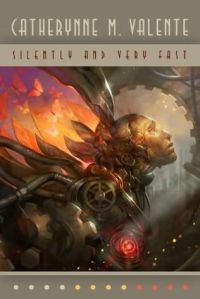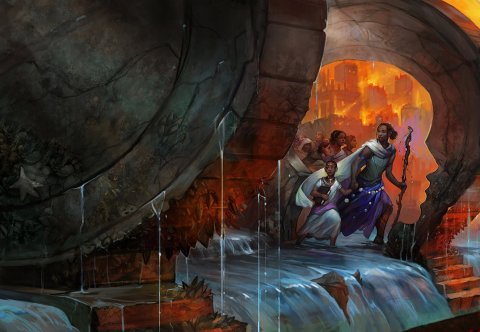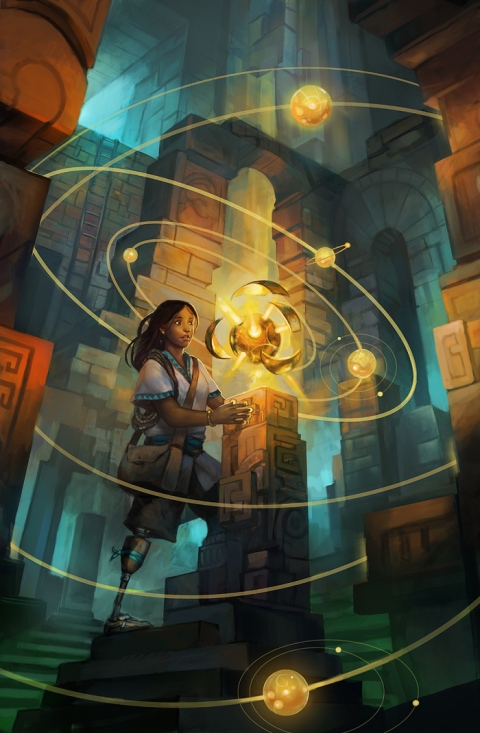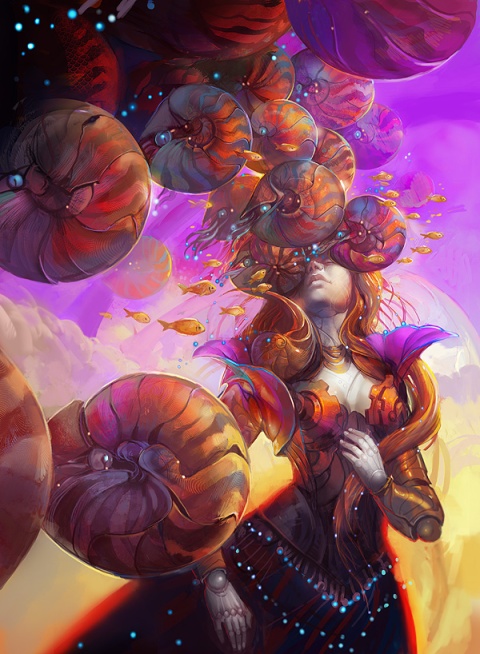Interview with Julie Dillon
Posted on: February 3, 2014
- In: Apex Publications | Blog tour | cover art | interviews | Julie Dillon
- 8 Comments
![Pageflex Persona [document: PRS0000040_00012]](https://littleredreviewer.wordpress.com/wp-content/uploads/2014/01/apex-blog-tour-banner.jpg?w=387&h=242) Ok blog tour participants and anyone else who has a copy of The Book of Apex Vol 4, raise your hand if you have a print copy. it looks wet, doesn’t it? I left the book on the kitchen table a few times, and even my husband wondered why I’d let water get on a book. The magical cover of this book, my friends, is the work of the unbelievably talented Julie Dillon.
Ok blog tour participants and anyone else who has a copy of The Book of Apex Vol 4, raise your hand if you have a print copy. it looks wet, doesn’t it? I left the book on the kitchen table a few times, and even my husband wondered why I’d let water get on a book. The magical cover of this book, my friends, is the work of the unbelievably talented Julie Dillon.
(in fact, all of the artwork you see in this post is by Julie Dillon)
That names rings a bell, doesn’t it? Oh yeah, she also did the cover art of the very first Subterranean Press special edition I bought for myself, Silently And Very Fast, by Catherynne M. Valente.
So it goes without saying that I was over the moon when Julie agreed to do an interview for this blog tour. When you’re just browsing through the bookstore, not looking for anything in particular, what do you gravitate towards? Interesting cover art, of course. Julie Dillon makes that cover art. She’s the reason you touch a book. She’s the reason I expected my finger to come away wet every time I picked up The Book of Apex: Volume 4 of Apex Magazine.
So let’s get to the interview!
LRR: You’ve won the Chelsea award twice, been nominated for the World Fantasy award and you were nominated for a Hugo Award for Best Professional Artist in 2013. What was it like to learn you had made the Hugo ballot? And speaking of, we’re right in the middle of nomination season. Are you eligible again this year?
J.D.: It was very validating to make the Hugo ballot. I didn’t think I’d be ready for that kind of recognition for another 5 years or so, and I was blown away that I was nominated. I was very honored and flattered that people saw anything of value in what I do. That said, I try not to let awards or nominations affect me too much, and I try to keep learning and working hard regardless of whether or not I am recognized. The recognition definitely helps, though, and goes a long way for helping me to reaffirm my decision to purse art fulltime. Getting awards and nominations encourages me to keep trying even harder.
I do have several pieces that are eligible for the Hugos this year. Andrea Höst was kind enough to put together a tumblr of various artists’ eligible work. My posts are available here and here.
LRR: Did you always want to be an artist? Can you tell us a little about your journey to becoming a professional artist?
J.D.: That’s a tricky question. I was always interested in drawing and creating, but it never really occurred to me that I could pursue art as my profession until my mid twenties. From all I had heard from other people, art was just something you do as a hobby in between your real work and real jobs. I spent much of my college life prepping for other careers, but I was always drawing and painting whenever I had free time. Eventually, thanks to the internet, I started noticing that there were such things as art schools, and professional artists, and people making a living doing a variety of types of art. I started wondering if maybe that was something I could do, too, and slowly I began taking actual art classes and investigating local art schools, and eventually started seeking out more freelance jobs. It took many long years before I got my portfolio up to a level where I was able to have fulltime freelance work, and I probably would have progressed faster if I had believed in myself more earlier on, but all things considered I think I’m doing an okay job of it.
LRR: What are your thoughts on traditional media (oil, acrylic, etc) vs digital?
J.D.: I think traditional media is vitally important, I think there are a lot of benefits to working in traditional media, and I enjoy doing working with real paint when I get the chance. But I think digital media is a valid tool, one that has it’s own strengths and weaknesses. So often I see people dismissing digital art as somehow cheating or not as valid or important as traditional art, but the computer is just another tool. It doesn’t do the work for you, you still need to have foundational drawing and painting skills to make a good digital piece. I personally prefer working digitally because it allows me to work quickly and cleanly. I don’t have to buy paint or brushes or canvases, I don’t have to wait for paintings to dry before sending them to clients, I don’t have to photograph or scan my final work, and I can make edits immediately and easily. But, I also do not have a physical original painting that I can hang up or sell, and I do miss out on the fun and satisfaction of working with real paint.
LRR: How long, on average, does it take you to complete a piece of art?
J.D.: It’s hard to tell, since I’m usually working on multiple illustrations that I rotate through, but I’ll usually spend at lease several days or weeks working on something. The actual time spent on any given piece are probably something like 8-20 hours, depending on the complexity.
LRR: Do you do commissioned pieces as well? How does that creative process differ from when you are creating a piece out of your mind?
J.D.: Most of my work is commissioned, although I don’t post all of it online. The main difference between commissioned work and work I do for myself is that if I’m doing for myself, I don’t have to worry about sticking to an art description or working for a specific audience or project. On the one hand, with commissioned work it’s sometimes nice having an art director to bounce ideas off of, because sometimes it’s difficult narrowing down concepts or compositions. But it’s also nice to be answerable only to myself and to work on projects where I have full control over how the piece progresses.
LRR: I really enjoyed the Digital Illustration Tutorial you have on your website, it really opened my eyes to all of the behind the scenes work that goes into art creation. do you think you’d do more tutorials like this?
J.D.: Thank you! I’m glad it made at least a little sense; I worry if I’m being coherent or helpful at all when I make those things. I might do more tutorials in the future, although I’m not sure what my focus would be. For the most part, my actual method of painting has remained the same. Any improvements I’ve been making have been because I’ve been going back and trying to work on my art foundation skills more with figure drawing and anatomy studies.
Want more of Julie’s artwork? Of course you do! Check out her website, and her deviant art site.
8 Responses to "Interview with Julie Dillon"
[…] Dillon (also on Deviant Art) Learn More: Apex Magazine interview and another interview at the Little Red Reviewer. She also has a couple of posts where you see her artistic […]
LikeLike
![Pageflex Persona [document: PRS0000040_00012]](https://littleredreviewer.wordpress.com/wp-content/uploads/2014/01/book-of-apex-v4.jpg?w=257&h=387)






February 3, 2014 at 9:14 am
Julie’s artwork is so beautiful! I’m sorry to say I only received a digital copy of THE BOOK OF APEX so I haven’t had a chance to see the cover in its physical form. I’ve always wished I had artistic skills, but I suppose enjoying the work of others is good enough:) Great interview!
LikeLike